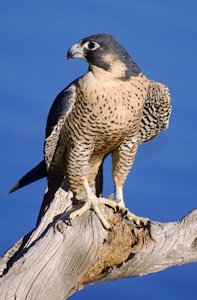
|
Bird Predation Techniques Predation involves a sequence of steps. Consider the hunting sequence of a Peregrine Falcon. The bird must first choose a place to hunt, locating regions and habitats where food is abundant. The next step is the search itself. For the Peregrine Falcon, this often entails soaring high above the earth, circling over places where ducks or other prey feed, until a likely victim appears. Once the falcon locates its prey, a chase begins. Peregrine Falcons stoop from on high, diving at enormous speeds and taking their victims by surprise. The chase may take several minutes of drama as the prey wheels and turns, frantically trying to avoid the fatal clasp of the talons. Falcons pursuing shorebirds on a mud flat swoop repeatedly after sandpipers and turnstones, forcing one bird to leave the flock and then hounding it with powerful, deep wing strokes that leave little hope of escape. The bigger victims may struggle, but most of the prey of Peregrine Falcons are too small to put up much of a struggle. To reduce its chance of becoming a predator's dinner, every bird utilizes some type of anti-predator behavior. But the evolution of both hunting behavior and anti-predator behavior has proceeded in a long series of steps, each a response to the other. |
| Peregrine Falcon | |
|
Each time a species of prey develops a new trait that enables it to more successfully avoid predation, the process of evolution may lead to a solution to the new trait, making the prey vulnerable once again. Sharp-shinned Hawks have made sparrows cautious; sparrows have made Sharp-shinned Hawks swift. |
|